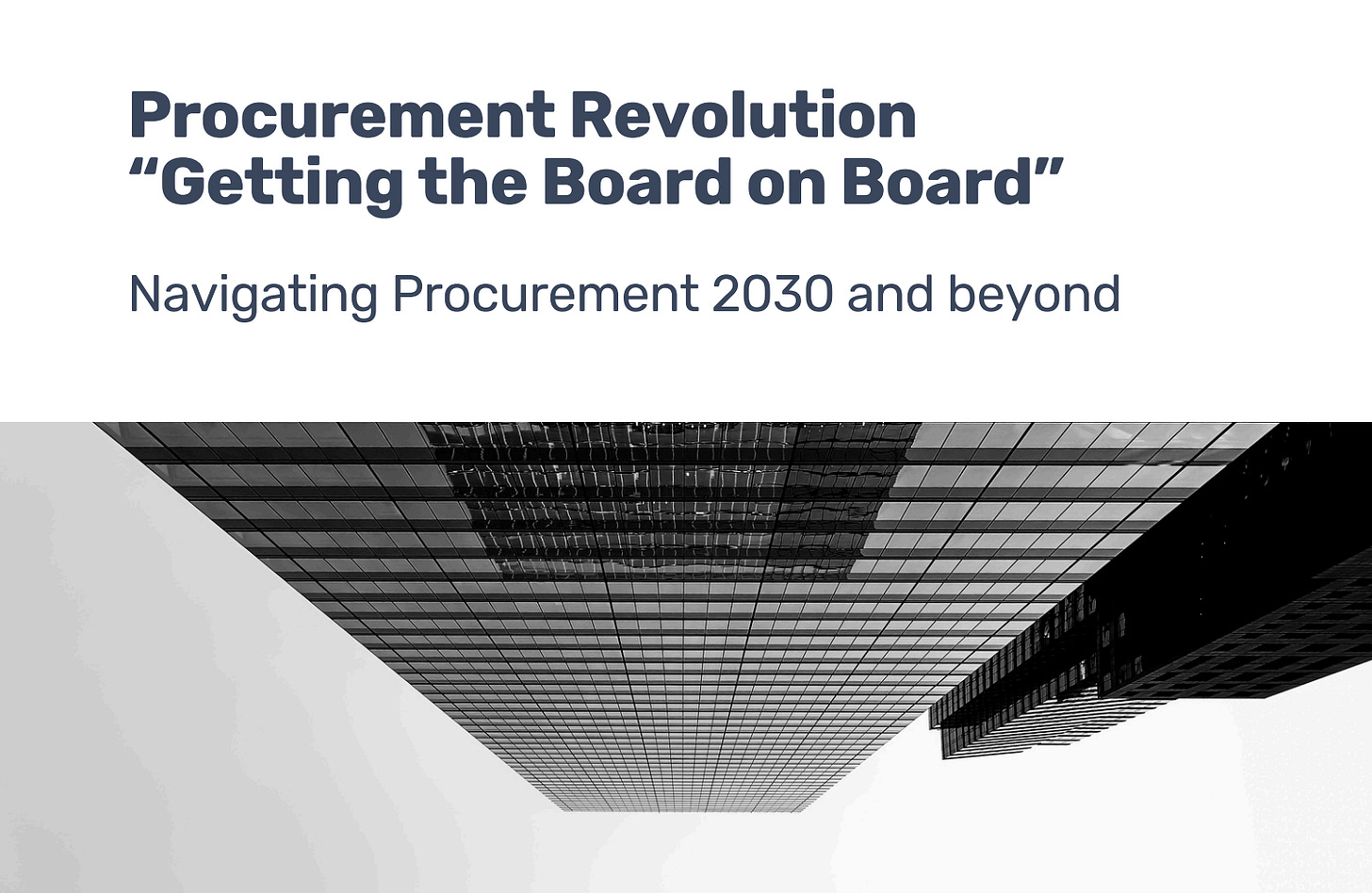The Procurement Revolution: How to Get Your Board on Board
Why Procurement Must Change and How CPOs Can Lead the Charge
Today’s procurement landscape is marked by rapid change, digital disruption, and a pressing need for strategic alignment with corporate goals. In the whitepaper, "Procurement Revolution – Getting the Board on Board," by Kathleen Harmeston and Jonathan O’Brien, the authors address the crucial need for procurement teams to adapt their strategies, operations, and skills to remain valuable and relevant to executive boards.
Here's a comprehensive summary of the insights from the paper, highlighting actionable recommendations procurement leaders can implement now.
Why Procurement Needs a Revolution
The Changing Global Dynamics
The global procurement landscape has drastically transformed over the last decade due to:
Increased geopolitical tensions, trade volatility, and sustainability legislation.
Accelerated use of automation and artificial intelligence (AI).
A heightened focus on Environmental, Social, and Governance (ESG) criteria.
Rising inflation and ongoing global economic uncertainty.
These factors have significantly broadened the procurement remit and increased the complexity and risk associated with the role.
“70% of CPOs see supply risk growing in the last 12 months.” — Spend Matters
The C-Suite Disconnect
Many executives still view procurement as merely a cost-cutting function rather than a strategic partner. To bridge this gap, CPOs must speak the language of the board, emphasizing how procurement contributes to business objectives, innovation, and growth.
A recent survey highlighted that only 39% of decision-makers see procurement as well-coordinated with other business functions like finance and technology—highlighting a critical communication gap.
The Role of the Modern CPO
Future CPOs will need to act as strategic business advisors rather than traditional procurement managers. Their roles will include:
Chief Price Officer: Optimizing supplier margins.
Chief Procurement People Officer: Focusing on strategic talent management.
Chief Procurement Projects Officer: Managing agile teams for high-value projects.
Chief Partner Officer: Enhancing supplier relationships.
Chief Prediction Officer: Anticipating supply chain risks and changes.
Chief Processing Officer: Streamlining operational purchasing processes.
Chief Programming Officer: Overseeing procurement technology initiatives.
Key Actions for Procurement Transformation
The paper outlines clear steps for procurement leaders to prepare their organizations for success:
1. Adopt Strategic Operating Models
Procurement must shift from a purely cost-focused approach to managing total cost of ownership (TCO). CPOs should:
Implement a center-led operating model to ensure consistency and efficiency.
Separate strategic from operational spend management.
Democratize procurement capabilities through intuitive, automated self-service tools for low-risk transactions.
2. Leverage Technology and AI
The strategic use of AI and automation is critical. Organizations should progress through these phases:
Embed (2025-2026): Automate low-value, repetitive tasks to free staff for higher-value activities.
Integrate (2027-2029): Implement predictive AI capabilities for cost forecasting, demand planning, and risk management.
Revolutionize (2030 onwards): Fully integrate AI-driven agents to automate tactical procurement, allowing teams to focus exclusively on strategic supplier management and innovation.
“80% of global CPOs plan on deploying GenAI in some capacity over the next 3 years.” — EY
3. Enhance Talent and Skills Development
CPOs face fierce competition in attracting and retaining skilled procurement talent. To address this, procurement leaders must:
Invest in continuous training in category management, ESG compliance, data analytics, and AI fluency.
Foster multifunctional teams with diverse, strategic skillsets to handle increasingly complex procurement challenges.
Create attractive career paths within procurement to retain top talent.
4. Ensure Board Alignment and Clear Communication
Effective communication with executive teams is crucial for securing buy-in. CPOs should:
Clearly articulate procurement’s value in terms of business risks, innovation opportunities, and EBITDA impact.
Align procurement KPIs directly with board-level strategic objectives.
Ensure transparent reporting and robust governance frameworks are in place.
Lessons from Leading Organizations
Leading procurement teams excel by consistently providing strategic insight, proactive risk management, and innovative solutions:
They manage supply chains proactively, not reactively, using predictive analytics.
They collaborate across functions to eliminate silos, fostering shared accountability.
They maintain agility, responding rapidly to market shifts and leveraging innovation from trusted supplier relationships.
Conclusion: Taking Action Today for Tomorrow’s Procurement
The procurement function of the future is dynamic, strategic, and deeply integrated into corporate decision-making. To achieve this vision, procurement leaders must invest in talent, adopt advanced technologies, and develop new operating models focused on agility and innovation.
Key Takeaways
Broaden Procurement’s Remit: Align procurement strategies closely with corporate goals and ESG priorities.
Invest in Technology: Use AI and automation strategically to shift resources from operational to strategic tasks.
Talent is Critical: Continuously upskill procurement teams to meet future challenges.
Join the Discussion
What challenges do you face in aligning your procurement function with your board's strategic vision? How are you preparing your team for future success?
We'd love to hear your insights and experiences, leave your comments below to join the conversation on shaping the future of procurement.



